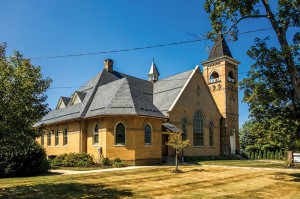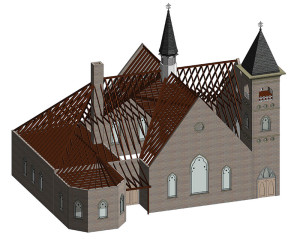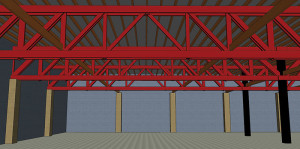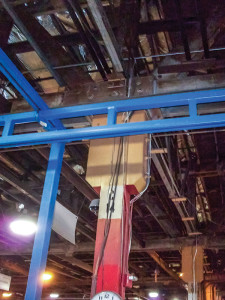Creative Problem Solving for Repairing Wood Structures
Structural repairs are never “one size fits all” and, by combining flexibility and creativity, structural engineering professionals can employ innovative approaches to repair older wooden structures. These creative solutions can foster goodwill with existing clients, gain new design commissions, and help develop a reputation as a thought leader in the process. NuTec Design has been able to realize these benefits by embracing innovation and thinking “outside of the wooden box.” The case studies that follow focus on a roof renovation for a historic church and the repair of wood trusses in two different buildings in the same business park.
Historic Church Roof Renovation
The first case study entailed a roof renovation for a historic church built in 1901 and located in Red Lion, PA (on the outskirts of York), as shown in Figure 1. On this project, the author’s firm was the second engineering firm called to investigate the church ceiling and roof. The client wanted to replace the existing slate roof with a new one, but during the original survey large cracks and deflections in the roof structure were discovered. These defects were due to the installation of a slate roof over the original built-up roofing material. The first engineering firm recommended a replacement of the entire roof structure. However, the cost associated with this replacement was too high for the client to absorb and created the possibility of damaging the historic plaster ceiling, so they opted for a second opinion. That was when NuTec received the call.
The overall construction is a multi-wythe masonry bearing wall with wood roof construction. Valley and ridge beams bear on the walls and support stick built trusses to create a vaulted ceiling space, attic floor, and roof rafters. The front auxiliary space and the front porch are framed independently. Figure 2 presents a 3D visual of the roof and ceiling framing.
During NuTec’s survey, several typical defects were observed throughout the structure. Cracks were noted in all of the ridge and valley beams and many of the rafters and vertical bracing members. These cracks reduced the expected load-carrying capacity of the members. Bowing vertical bracing members, indicating significant load-demand in main members, were common across the structure and appeared to be due to the additional load from the slate roof.
Although the first survey stated that the existing members were not salvageable, in-depth analysis after the second survey indicated the existing members were not far over their demand-to-capacity values for the existing load conditions. The biggest concern was the slate roof built on top of layers of old roofing material. The slate roof was heavier than the original built-up roof, but the prior roof material was not removed as it should have been, compounding the problem of installing a heavier roof material.
The author’s firm recommended removing all the old roofing materials and then reinforcing the cracked members before laying the new slate roof. First, the damaged and deteriorated rafters were addressed. After the old roofing materials had been removed and the dead load relieved, the damaged rafter and vertical member sections were removed and replaced with 2×12 members. The next step was to address the cracked valley beams. An epoxy crack injection system was used to fill the cracks, and then the damaged members were reinforced with 2x12s to support the new slate roof loads. The repairs were completed in 2010, and the structure has not exhibited deterioration based on subsequent, periodic structural inspections.
Commercial Business Park (Building 1)
The second case study is a single-story manufacturing building located in Central Pennsylvania and is similar in construction to many of the buildings in the surrounding business park. The building, constructed in the 1940s, consists of wood trusses. Within the last 20 years, the building was sold and the center bay replaced with a raised pre-engineered truss section. No modifications were done to the original wood trusses to support the additional drifted snow load due to the raised center roof portion. The client noticed cracks in the wood and engaged NuTec to complete a survey, analyze the trusses, and provide repair documents if necessary.
The overall construction of the building is a multi-wythe masonry bearing wall with integral piers. A raised center bay of 60-foot long pre-engineered steel frames was installed after the original building was constructed. Wood trusses supported by the steel frames span approximately 60 feet and wood purlins, 20 feet long, span between them. There are a few interior walls built next to, or around the existing trusses. Refer to Figure 3 for a section displaying the truss construction and raised center bay.
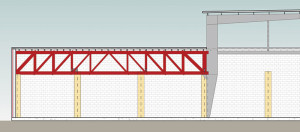
Figure 3. Section of the pre-engineered metal bay and wood truss bay in the building from Case Study two.
During the survey, typical defects were noted throughout the structure. The defects noticed most frequently were checks in the top and bottom of many members through the member connections. These connections were comprised of 4-inch diameter split-rings. The checks at the member ends reduced the capacity of the connections. Some members had cracks against the wood grain, and most of the members had cracks through a portion of the member length along the wood grain. These cracks undermined the structural integrity of the members and reduced the load carrying capacity.
Five different options were evaluated, and order-of-magnitude estimates were developed for the main repairs to the structure:
- Intermediate wood posts: $200,000
- Steel plate or channel reinforcement: $400,000
- Epoxy crack sealer system: $600,000
- Replacing or sistering the members: $800,000
- New steel beam, column, and foundation support system: $1,000,000
NuTec immediately disregarded the new steel beam and column option as it was the highest cost and would interfere with the manufacturing process, which drives the structure. The intermediate wood post option was similarly rejected due to manufacturing process interference. Replacing or sistering with wood members would be costly due to the size of the reinforcing required as a result of the amount of drifted snow from the raised center bay. Consequently, the client selected the option of reinforcing existing elements with steel plate or channel, a lesser cost option when compared to epoxy crack sealing. There were minimal utilities supported from the existing trusses that would be disturbed during the repair as well, making it the more cost-effective and least operational impact of all the repair options suggested.
The typical repair involved plating the bottom chord and center web members, in all trusses, to reinforce for the drifted snow load. Members with significant cracks were then plated to improve the load carrying capacity. Finally, the checks were filled with an epoxy crack sealer to repair the bearing of the split ring connection.
Commercial Business Park (Building 2)
The last case study is a manufacturing building located in Central Pennsylvania in the same business park as the previous case study. Again, this building was constructed in the 1940s and employs wood trusses. This client owns approximately 13 similar buildings in this business park and they called NuTec because they had a truss failure in another building during a snow event.
A different engineering firm designed repairs in the failed building, utilizing new steel beams, columns, and concrete foundations. The invasiveness of the work necessitated the relocation of utilities and, as a result, all the utilities were brought up to code. The client did not feel this solution was optimal for their situation but wanted to ensure that their other buildings were safe for occupants. That is when the author’s team was asked to do a condition survey and provide recommendations.
Again, this is a single-story industrial building. The overall construction of the building is a multi-wythe masonry bearing wall with integral piers and interior wood columns. The piers and interior wood columns support the wood trusses and span approximately 60 feet with 20-foot wood purlins spanning between the trusses. Figure 4 shows a 3D interior view of the building with the wood trusses highlighted in red.
During the survey, typical defects, similar to the previous case study, were noted throughout the structure. Also, the structure was littered with existing utilities and crane runway beams as illustrated in Figure 5. The owner instructed the team not to disturb any of the existing utilities or crane beams, or disrupt the operation of the building. All of these existing conditions and restrictions made for a unique and challenging repair project.
Again the same five options were considered, and order-of-magnitude estimates were prepared for the main repairs to the structure:
- Intermediate wood posts: $200,000
- Replacing or sistering the members: $300,000
- Epoxy crack sealer system: $600,000
- Steel plate or channel reinforcing: $800,000
- New steel beam, column, and foundation support system: $1,000,000
Although the cost estimates are similar to the previous case study, replacing with wood members was cheaper than using steel plate and channels on this project. The building did not require reinforcing for snow drift, so the wood members were smaller and easier to handle. Furthermore, any steel reinforcing would have disrupted the utilities, causing relocation in some areas and resulting in higher costs due to the relocation.
The client immediately rejected new steel beams and columns. The steel approach was utilized in their first building, and they felt that the utility disruption and new foundations required to support the columns was not cost-effective. Intermediate wood posts were also not acceptable due to the disruption this would pose to the building operations, and replacing in-kind was ruled out due to the disruption of the existing utilities. The epoxy crack sealer was the option selected, as it was the lower cost option between the remaining two and it was the least invasive on the existing utilities.
Creative Engineering as a Marketing Tool
Creative and flexible solutions can be used to market your company, generating many different ways to gain new clients or design commissions. The author’s firm has experienced specific benefits.
Company exposure: Many prominent community leaders attend the church in the first case study. The consideration of options to save the church gained exposure for the firm, demonstrating their willingness to work with the community. This project preserved an important aesthetic in a historic church and caught the attention of those community leaders who will recognize this effort for the next project that requires a creative solution.
Set your company apart: Start to stand out as a firm with custom designs for buildings of a certain era or construction-type. Know how to work with inexpensive solutions that pose as little impact on facility function as possible. Incorporate creativity in your problem solving and leverage it to gain more business. By working with the owner of the property in the business park example and providing a series of options, NuTec was able to work on eleven more buildings of similar construction in the same business park. This client is also a national property owner and solicited assistance on projects in other locations including sites around Central Pennsylvania and beyond.
Thought leadership: Thought leaders are recognized as the foremost authorities in their field. Their expert opinions are sought by others looking for information in that field. By building a portfolio in a specific or unique project type, one can gain recognition as a thought leader. Ultimately, the goal is to have prospects seek you out because of your unique knowledge or skill set. By engineering creative solutions, the author’s firm has become a thought leader in certain fields, with new and existing clients requesting expert opinion and engineering skills.
Content Marketing: Creative engineering can lead to content marketing. You can start to generate blogs, case studies, and interviews to generate interest in your firm’s website. This digital presence establishes your firm as a creative problem solver. NuTec has been approached to propose on projects due to content on their company blog, which has, in turn, led to creating valued partnerships with repeat clients.
Personal and professional brand: A personal brand is how professionals market themselves and their careers to others. Clients want to work with individuals they trust to design the best solution to fit their needs. By designing innovative and creative solutions for clients, you enhance your personal brand in the eyes of that client. The brand, in turn, increases the value of your company. You gain their respect and admiration, which will hopefully turn them into a repeat partner in the future.
In engineering, we are trained to look at things in black and white terms. However, there are many times when the best solution is in a gray area, where creativity and innovation reside. This is the time for multiple potential solutions that weigh all the variables that can influence the outcome.
In each case study, the individual concepts outlined were only a piece of the final solution for the client. As professionals, we have to balance client needs, cost, value, and engineering judgment to recommend a solution that fits a client’s budget, as well as the overall needs of the process or function of the space.▪

